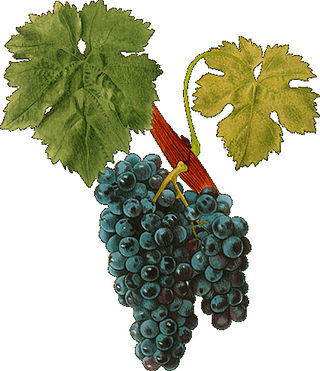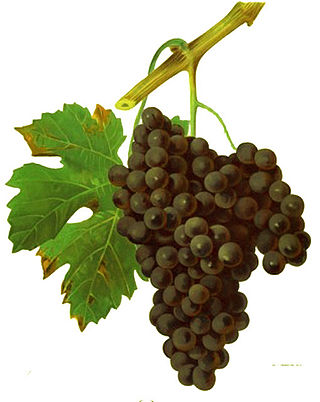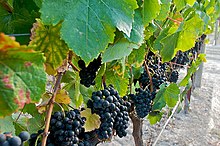
Merlot is a dark blue–colored wine grape variety that is used as both a blending grape and for varietal wines. The name Merlot is thought to be a diminutive of merle, the French name for the blackbird, probably a reference to the color of the grape. Its softness and "fleshiness," combined with its earlier ripening, make Merlot a popular grape for blending with the sterner, later-ripening Cabernet Sauvignon, which tends to be higher in tannin.

Cabernet Sauvignon is one of the world's most widely recognized red wine grape varieties. It is grown in nearly every major wine producing country among a diverse spectrum of climates from Australia and British Columbia, Canada to Lebanon's Beqaa Valley. Cabernet Sauvignon became internationally recognized through its prominence in Bordeaux wines, where it is often blended with Merlot and Cabernet Franc. From France and Spain, the grape spread across Europe and to the New World where it found new homes in places like California's Napa Valley, New Zealand's Hawke's Bay, South Africa's Stellenbosch region, Australia's Margaret River, McLaren Vale and Coonawarra regions, and Chile's Maipo Valley and Colchagua. For most of the 20th century, it was the world's most widely planted premium red-wine grape until it was surpassed by Merlot in the 1990s. However, by 2015, Cabernet Sauvignon had once again become the most widely planted wine grape, with a total of 341,000 hectares (3,410 km2) under vine worldwide.

Cabernet Franc is one of the major black grape varieties worldwide. It is principally grown for blending with Cabernet Sauvignon and Merlot in the Bordeaux style, but can also be vinified alone, as in the Loire's Chinon. In addition to being used in blends and produced as a varietal in Canada, the United States and Argentina, it is sometimes made into ice wine in those regions.

Meritage is a name for red and white Bordeaux-style wines without infringing on the Bordeaux (France) region's legally protected designation of origin. Winemakers must license the Meritage trademark from its owner, the California-based Meritage Alliance. Member wineries are found principally in the United States, though increasingly elsewhere.

Malbec is a purple grape variety used in making red wine. The grapes tend to have an inky dark color and robust tannins, and are known as one of the six grapes allowed in the blend of red Bordeaux wine. In France, plantations of Malbec are now found primarily in Cahors in South West France, though the grape is grown worldwide. It is also available as an Argentine varietal.

Carignan is a red grape variety of Spanish origin that is more commonly found in French wine but is widely planted throughout the western Mediterranean and around the globe. Along with Aramon, it was considered one of the main grapes responsible for France's wine lake and was a substantial producer in jug wine production in California's Central Valley but in recent years, it has been reborn as a flagship wine for many cellars in the south of France as well as in Catalonia.

Folle blanche, also known as Picpoule, Gros Plant, and Enrageat blanc, is a wine grape variety from southwest France. It was the traditional grape variety in Cognac and Armagnac production until the 20th century. Folle blanche is an offspring of Gouais blanc, with the other parent so far unidentified.

The Carménère grape is a wine grape variety originally planted in the Médoc region of Bordeaux, France, where it was used to produce deep red wines and occasionally used for blending purposes in the same manner as Petit Verdot.

Petit Verdot is a variety of red wine grape, principally used in classic Bordeaux blends. It ripens much later than the other varieties in Bordeaux, often too late, so it fell out of favour in its home region. When it does ripen it adds tannin, colour and flavour, in small amounts, to the blend. Petit verdot has attracted attention among winemakers in the New World, where it ripens more reliably and has been made into single varietal wine. It is also useful in 'stiffening' the mid palate of Cabernet Sauvignon blends.

Bordeaux wine is produced in the Bordeaux region of southwest France, around the city of Bordeaux, on the Garonne River. To the north of the city, the Dordogne River joins the Garonne forming the broad estuary called the Gironde; the Gironde department, with a total vineyard area of 110,800 hectares, is the second largest wine-growing area in France behind the Languedoc-Rousillon.

Mondeuse noire is a red French wine grape variety that is grown primarily in the Savoy region of eastern France. The grape can also be found in Argentina, Australia, California, Switzerland and Sicily. Plantings of Mondeuse noire was hit hard during the phylloxera epidemic of the mid to late 19th century which nearly wiped out the vine from eastern France. While the grape recovered slightly in the 20th century, French plantations of Mondeuse noire fell sharply in the 1970s, with just over 200 hectares left in France in 2000. In the early 21st century, it seems the variety has increased somewhat in popularity, as it can give good wines if the planting site is chosen carefully.
Bouchalès or Grapput is a red French wine grape variety that is grown primarily in Bordeaux and Southwest France wine appellations. Plantings have declined in recent years as the vine has shown high sensitivity to downy mildew and black rot.
Abouriou is a red French wine grape variety grown primarily in Southwest France and, in small quantities, California. It is a blending grape that, along with Malbec, Cabernet Sauvignon, Syrah, Fer, Cabernet Franc, and Merlot, is used to make the Appellation d'origine contrôlée (AOC) wine of Côtes du Marmandais. Abouriou can also be made into a varietal, as it is used in some vin de pays wines. The grape is known for its low acidity and high tannin content.

Duras is a traditional French variety of red wine grape that is mostly grown around the river Tarn, northeast of Toulouse. It is usually blended with other traditional varieties, but production has been declining in recent years.

Aramon or Aramon noir is a variety of red wine grape grown primarily in Languedoc-Roussillon in southern France. Between the late 19th century and the 1960s, it was France's most grown grape variety, but plantings of Aramon have been in continuous decline since the mid-20th century. Aramon has also been grown in Algeria, Argentina and Chile but nowhere else did it ever reach the popularity it used to have in the south of France.

Grand Noir de la Calmette is a red teinturier grape variety that is a crossing of Petit Bouschet and Aramon noir created in 1855 by French grape breeder Henri Bouschet at his vineyard in Mauguio in the Hérault department. The grape was named after the breeding station Domaine de la Calmette. As a teinturier, Grand noir is often used to add color to wines that it is blended into but is paler than other choices such as Alicante Bouschet. The vine tends to bud late and has a high productivity but with some susceptibility to the viticultural hazard of powdery mildew.

Marselan is a red French wine grape variety that is a cross between Cabernet Sauvignon and Grenache. It was first bred in 1961 by Paul Truel near the French town of Marseillan. The vine is grown mostly in the Languedoc wine region with some plantings in the Northern Coast of California. It has also become very popular in China. The grape usually produces a medium body red wine.

Ondenc is a white French wine grape found predominantly in the Gaillac region of southwest France. In the 19th century, it was a popular planting in Bordeaux but fell out of favor following the phylloxera epidemic due to poor yields and sensitivity to grape disease, though is still one of the seven white varieties permitted in Bordeaux. Prior to falling out of favor, vine cuttings were brought from Bordeaux to Australia where the grapes became known under the synonyms of Irvine's White in Victoria and Sercial in South Australia. The Australian grapes weren't identified as Ondenc till 1976 when French ampelographer Paul Truel identified the vine while visiting Australia. Today, the grape is nearly extinct in Australia except for a small amount of plantings in Victoria used in sparkling wine production.
Béquignol noir is a red French wine grape variety that originated in Southwest France. However it is now more widely grown in the Mendoza wine region of Argentina where it is often used to add color to blends. The grape is often confused with several other red wine varieties such as Cabernet Franc, Durif, Fer and Prunelard with Béquignol noir sharing several synonyms with these grapes. However DNA profiling has shown Béquignol noir to be distinct from those grape varieties. Further research in 2011 showed that Béquignol noir may have a parent-offspring relationship with the Savagnin grape.

Arrouya noir is a red French wine grape variety grown in the Jurançon region of Southwest France. The grape has a long history in the region, growing in the Pyrénées-Atlantiques since at least the late 18th century. Ampelographers believe that Arrouya noir has some genetic relationship with Camaraou noir, Fer and Petit Courbu though the exact nature of those relationships is not yet known. The variety also shares some similarities in morphology with Cabernet Franc and until the late 19th century was often confused for the Loire and Bordeaux wine grape, especially in the Basses-Pyrénées and Hautes-Pyrénées region.


















